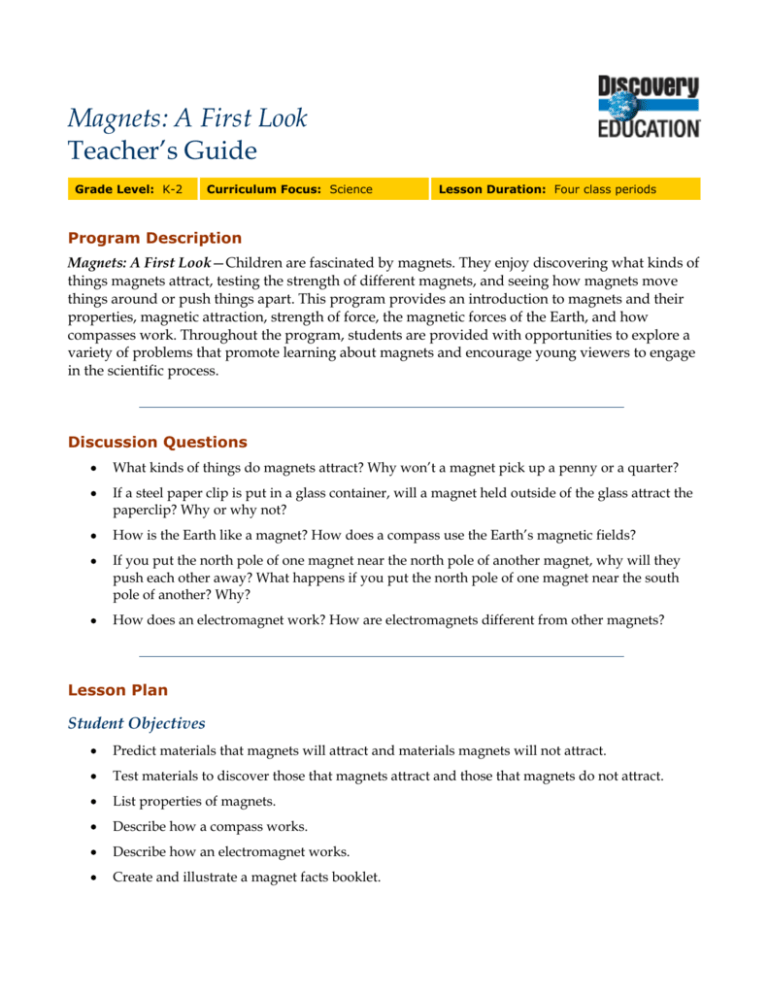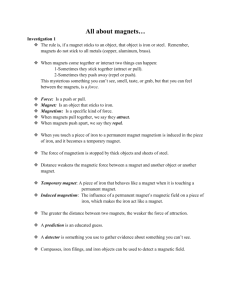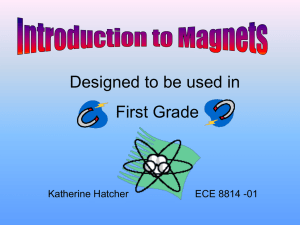
Magnets: A First Look
Teacher’s Guide
Grade Level: K-2
Curriculum Focus: Science
Lesson Duration: Four class periods
Program Description
Magnets: A First Look—Children are fascinated by magnets. They enjoy discovering what kinds of
things magnets attract, testing the strength of different magnets, and seeing how magnets move
things around or push things apart. This program provides an introduction to magnets and their
properties, magnetic attraction, strength of force, the magnetic forces of the Earth, and how
compasses work. Throughout the program, students are provided with opportunities to explore a
variety of problems that promote learning about magnets and encourage young viewers to engage
in the scientific process.
Discussion Questions
•
What kinds of things do magnets attract? Why won’t a magnet pick up a penny or a quarter?
•
If a steel paper clip is put in a glass container, will a magnet held outside of the glass attract the
paperclip? Why or why not?
•
How is the Earth like a magnet? How does a compass use the Earth’s magnetic fields?
•
If you put the north pole of one magnet near the north pole of another magnet, why will they
push each other away? What happens if you put the north pole of one magnet near the south
pole of another? Why?
•
How does an electromagnet work? How are electromagnets different from other magnets?
Lesson Plan
Student Objectives
•
Predict materials that magnets will attract and materials magnets will not attract.
•
Test materials to discover those that magnets attract and those that magnets do not attract.
•
List properties of magnets.
•
Describe how a compass works.
•
Describe how an electromagnet works.
•
Create and illustrate a magnet facts booklet.
Magnets: A First Look
Teacher’s Guide
2
Materials
•
Magnets: A First Look video
•
Computer with Internet access
•
A selection of bar, horseshoe, wand, and disc magnets; one small wand or horseshoe magnet
per student
•
Materials for recreating program demonstrations: magnets, iron and steel nails, screws or nuts,
small boxes with lids, steel pins, buttons, marbles, steel paper clips, string, ball bearings, iron
filings, square of glass
•
A variety of everyday items made of materials that a magnet will and will not attract, including
various metals other than iron or steel (Procedures 1 and 2)
•
A variety of items such as a plastic cup, glass jar, sheets of paper, thin piece of plywood, sheet of
tinfoil, book, coins, and a ceramic container. (Procedure 6)
Procedures
1. Before students view the program, set up a display of everyday items made of materials that a
magnet will and will not attract. Ask students to share what they know about magnets. Once
students have offered their responses, show them a variety of magnets (horseshoe, bar, disc,
wand) and demonstrate how a magnet works, using each type with steel paper clips and plastic
buttons. Ask students to predict which of the items in your display will be attracted to the
magnet and which will not. Place the items into two separate piles without testing student
predictions. Tell students to keep their predictions in mind while they watch the program.
2. After students view the program, have them take another look at the items categorized in
Procedure 1. Ask students whether they now think any items should be moved from one pile to
another. Why? Test each item, and then discuss the accuracy of student predictions.
3. Ask students to explore the classroom to find any magnets located there. Help them discover
classroom magnets such as magnetic letters or numbers, a magnetic paper clip holder, a
magnetic bulletin board, magnetic cupboard latches, and so on.
4. Provide each student with a magnet and a large piece of paper divided into two columns.
Permit them to walk around the room and gather five small items and bring them back to their
desks. Have students use their magnets to test the items. Are any attracted to the magnet? Ask
students to record their findings on the piece of paper by drawing the items that are attracted to
the magnet in the left hand column and the items that are not in the right hand column. Display
completed charts.
5. Magnet Facts—Ask students to brainstorm what they learned about magnets in the program.
Record these facts on the board. Facts should include the following:
•
Magnets attract iron and steel.
•
A magnet does not have to touch something to attract it.
•
A magnet can attract something through another material, such as paper or glass.
Published by Discovery Education. © 2005. All rights reserved.
Magnets: A First Look
Teacher’s Guide
•
A magnet will attract and push away (repel) another magnet.
•
Magnets have two poles.
•
The poles of a magnet are called north and south.
•
Like magnetic poles repel.
•
Opposite magnetic poles attract.
•
The force of a magnet is strongest at its poles.
•
The space around a magnet is called a magnetic field.
3
6. Magnet Facts Booklet—After creating a list such as the one above, have students copy and
illustrate each fact on a separate piece of paper. Once pages are completed, have students staple
them together to create their own magnet facts booklet. (Note: This activity may need to be
modified for very young students.)
7. Home Inspection—Lend each student a small wand or horseshoe magnet to use at home. Ask
students to test items around the house, keeping a list of items tested and making a note
whether the attraction was weak, strong, or nonexistent. Have students share and discuss their
findings. Did students expect some items to be attracted which were not? If so, what were they?
Did any items surprise students by being attracted to the magnet? If so, which ones? Were some
items more strongly attracted to the magnet than others? Which items? Why would some items
be more strongly attracted to a magnet than others?
8. For this activity have students work in small, supervised groups. Provide students with several
magnets of different strengths, along with paper clips and a variety of items such as a plastic
cup, a glass cup, a sheet of paper, a thin piece of plywood, a wooden or metal ruler, a sheet of
tinfoil, a book, coins, and a ceramic dish. Take each item in turn and place it between one of the
magnets and the paper clips. Move the magnet. Record the results on the board or a piece of
paper. Do the paper clips move when the magnet moves? Does the movement of the paper clips
depend on the strength of the magnet? Through how many pages of the book is each of the
magnets able to attract? Are any of the magnets able to attract through metals? Put water in the
glass jar or ceramic dish and place paper clips in the water. Can the magnet attract the paper
clips through water?
9. On small slips of paper, write questions based on information gathered in this program and
from the above activities. Create at least one question per student. Put a small steel paper clip
on each slip of paper, fold each paper twice, and place them all in a basket or box. Using a stick,
a piece of string, and a small horseshoe magnet, make a fishing pole and have each student
“fish” for a question which he or she must read aloud and answer. (Note: Test for strength of
magnet and placement of clip for best results. Modify this activity for younger students by
reading the questions to them once the questions have been “caught.”)
Published by Discovery Education. © 2005. All rights reserved.
Magnets: A First Look
Teacher’s Guide
4
Assessment
Use the following three-point rubric to evaluate students’ work during this lesson.
•
3 points: Students were attentive and highly engaged in class discussions; participated fully
in program-related activities and the home inspection assignment; produced a neat, wellillustrated magnet facts booklet that demonstrated clear understanding of the topic.
•
2 points: Students participated in class discussions; participated sufficiently in programrelated activities and the home inspection assignment; produced a satisfactory magnet facts
booklet that demonstrated adequate understanding of the topic.
•
1 point: Students participated minimally in class discussions; participated minimally in
program-related activities and the home inspection assignment; produced an unsatisfactory
magnet facts booklet that demonstrated poor understanding of the topic.
Vocabulary
attract
Definition: To draw objects nearer
Context A magnet attracts objects made of iron or steel.
compass
Definition: A device that uses a magnetic needle to determine direction
Context: The magnetic north arrow of a compass always points to the Earth’s magnetic north.
electromagnet
Definition: A temporary magnet made by passing an electric current through a wire coiled
around an iron bar
Context: An electromagnet can be made stronger by adding a stronger electrical current to the
wire coil.
magnet
Definition: An object that has a magnetic field and is able to attract iron and steel
Context: Every magnet has at least one north pole and one south pole.
magnetic field
Definition: The area around a magnet where it exerts a magnetic force
Context: A magnet’s magnetic field is strongest near its poles.
north pole
Definition: The pole of a magnet that is attracted to the Earth’s north magnetic pole
Context: The north pole of one magnet will push away the north pole of another magnet.
Published by Discovery Education. © 2005. All rights reserved.
Magnets: A First Look
Teacher’s Guide
pole
Definition: The place on a magnet where the magnetic force is strongest
Context: If you break a bar magnet in two, each new piece will have a north pole and a south
pole.
south pole
Definition: The pole of a magnet that is attracted to the Earth’s south magnetic pole
Context: The south pole of one magnet will be attracted to the north pole of another magnet.
Academic Standards
National Academy of Sciences
The National Academy of Sciences provides guidelines for teaching science in grades K–12 to
promote scientific literacy. To view the standards, visit this Web site:
http://books.nap.edu/html/nses/html/overview.html#content.
This lesson plan addresses the following national standards:
•
Science as Inquiry: Abilities necessary to do scientific inquiry; Understanding about
scientific inquiry
•
Physical Science: Properties of objects and materials; Light, heat, electricity, and magnetism
•
Earth and Space Science: Properties of earth materials
Mid-continent Research for Education and Learning (McREL)
McREL’s Content Knowledge: A Compendium of Standards and Benchmarks for K–12 Education
addresses 14 content areas. To view the standards and benchmarks, visit
http://www.mcrel.org/compendium/browse.asp.
This lesson plan addresses the following national standards:
•
Science—Physical Sciences: Understands the structure and properties of matter;
Understands the sources and properties of energy; Understands forces and motion
•
Science—Nature of Science: Understands the nature of scientific inquiry
•
Life Skills—Thinking and Reasoning: Effectively uses mental processes that are based on
identifying similarities and differences; Understands and applies basic principles of
hypothesis testing and scientific inquiry; Applies basic trouble-shooting and problemsolving techniques
•
Language Arts—Viewing: Uses viewing skills and strategies to understand and interpret
visual media
Published by Discovery Education. © 2005. All rights reserved.
5
Magnets: A First Look
Teacher’s Guide
6
Support Materials
Develop custom worksheets, educational puzzles, online quizzes, and more with the free teaching tools
offered on the DiscoverySchool.com Web site. Create and print support materials, or save them to a
Custom Classroom account for future use. To learn more, visit
http://school.discovery.com/teachingtools/teachingtools.html.
Credit
Patricia A. Peirson, freelance writer; former elementary school and adult ESL educator
Published by Discovery Education. © 2005. All rights reserved.









